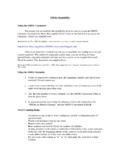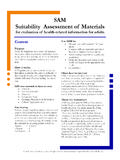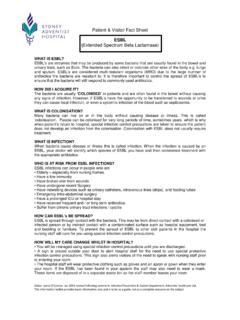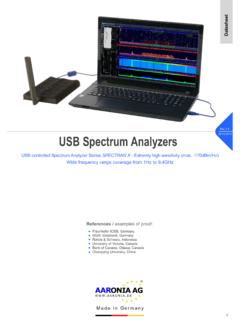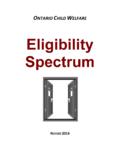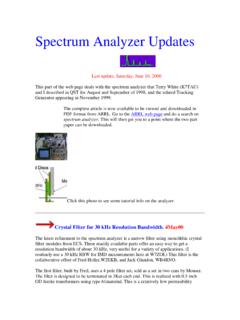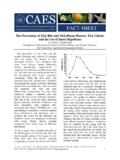Transcription of Extended-Infusion Piperacillin/Tazobactam (Zosyn ...
1 Extended-Infusion Piperacillin/Tazobactam ( zosyn ) protocol for Adult Patients 9/20/2016 TTO PURPOSE piperacillin - tazobactam (PTZ) is a commonly used broad- spectrum -lactam antibiotic. Like all -lactam antibiotics, its bactericidal activity is dependent upon the percentage of time that free drug is above the minimum inhibitory concentration (MIC) of an organism (%fT>MIC). In an era of increasing antimicrobial resistance and few new treatment options, it has become necessary to enhance the pharmacokinetic/pharmacodynamic (PK/PD) properties of our current antibiotics. Traditionally, PTZ has been given via a 30 minute intermittent- infusion . However, studies have shown that we can optimize the activity of PTZ to treat more resistant Gram-negative organisms, such as Pseudomonas aeruginosa, through the use of an Extended-Infusion (EI) given over 4 hours. In the case of PTZ this also results in less drug being given and subsequent cost savings.
2 This protocol outlines the procedures for the automatic interchange of intermittent- infusion PTZ (infused over 30 min) to EI PTZ (infused over 4 hours) for adult patients at all Aspirus acute care locations. The goals of this protocol are to: - optimize clinical outcomes - reduce resistance rates - standardize Epic and Smart pump programming - decrease drug costs. BACKGROUND The recommended fT>MIC to maximize the bactericidal effects of PTZ is 50-60%.1 The probability of attaining this target in a population of individuals is termed the probability of target attainment (PTA), and ideally is > 90%. The following are studies supporting the use of EI PTZ: 1. Lodise TP, et al. Pharmacotherapy. 2006;26(9) Lodise TP, et al. CID. 2007; 44:357 Lodise and colleagues utilized Monte-Carlo simulation to identify alternative ways of administering PTZ to optimize clinical The standard dosing strategies using intermittent infusions did not provide high probabilities of target attainment for the treatment of P.
3 Aeruginosa infections with MIC > 8 mg/L. The probabilities of target attainment of 50% fT>MIC for PTZ were as follows (Figure 1): o q6h (30 min infusion ): > 90% for MIC values 1 mg/L o q4h (30 min infusion ): > 90% for MIC values up to 8 mg/L o q8h (4 hour infusion ): >90% for MICs up to 16 mg/L The extended 4 hour infusion of PTZ IV every 8 hours achieved a PTA > 90% for an MIC < 16 mg/L, and at a lower total daily dose. Figure 1: Probabilities of Target Attainment with In 2007, Lodise and colleagues published a study in which they utilized the results of this Monte-Carlo simulation to alter the use of PTZ in their clinical A retrospective cohort study was performed in 194 critically ill patients with P. aeruginosa infections to compare outcomes in those who received EI PTZ ( IV every 8 hours infused over 4 hours) versus intermittent- infusion PTZ ( IV q4-6h infused over 30min). Among the most critically ill patients (APACHE-II scores 17), EI PTZ resulted in significantly lower 14-day mortality ( vs.)
4 , respectively; P= ) and duration of hospital stay (21 days vs. 38 days; P= ) when compared to those who received intermittent- infusion therapy. 2. Patel GW, et al. Diagn Microbiol Infect Dis. 2009;64(2) In 2009, Patel et al. published a retrospective cohort study evaluating the clinical outcomes of EI PTZ ( IV q8 hours infused over 4 hours) versus intermittent- infusion PTZ ( IV q6-8 hours infused over 30min) in 129 Similar mortality and length of stay were found for both the lower-dose EI PTZ and standard-dose intermittent- infusion PTZ groups. 3. Patel N, et al. Antimicrob Agents Chemother. 2010; 54(1) In 2009, Patel et al. published a study examining the effects of various levels of renal function on the PK/PD parameters of intermittent and EI PTZ utilizing population PK This study found improved PTA for EI PTZ when renally adjusted to be given every 12 hours in those with a CrCl 20 mL/min.
5 4. Yost RJ, et al. Pharmacotherapy. 2011; 31(8) In 2011, The Retrospective Cohort of Extended-Infusion piperacillin - tazobactam (RECEIPT) study group performed a multi-center retrospective study comparing EI PTZ to that of intermittently dosed comparator a. In-hospital mortality was significantly decreased for the EI PTZ group versus those receiving comparator antibiotics ( vs ; P= ). Multivariate analysis confirmed that EI PTZ increased survival by days (P< ) and reduced mortality (OR ; P= ). Economic Evaluation Current costs at Aspirus Wausau Hospital: zosyn gm premixed bag = $ gm premixed bag = $ gm premixed bag = $ Table 1: Treatment cost comparisons. Dose Cost per day Difference in Cost After 10 Days Day 1 Day 7 Day 10 Intermittent- infusion q6h $ $ $ $ q8h $ $ $ $ q6h $ $ $ $ Extended-Infusion gm q8h over 4 hrs $ $ $ Table 2: Current usage at the Aspirus hospitals from June August 2016* Hospital Eligible orders Current compliance with EI Pip/Tazo Potential annual savings AWH 366 92% 0 AIR 38 95% 0 AGV 28 21% $1,500 AKH 30 0% $2,400 Aspirus Total* 462 82% $3,900 *Does not include ALH (no orders), AMH (1 order), ARH (not on Epic) Interchange procedure: 1.
6 Pharmacists will automatically interchange all adult orders for intermittent- infusion doses of PTZ to EI PTZ based on Table 3 below, except one-time orders for the OR/PACU, ER, and ambulatory care areas. If PTZ is continued after a one-time dose is given over 30 minutes in the ER or OR/PACU, the next dose is given 6 hours after the first dose as an EI over 4 hours with subsequent EI doses given every 8 hours after that, per the standard schedule. a. If a provider chooses not to use an EI, they may write Do not change to Extended-Infusion on the order, and the pharmacist will verify the intermittent 30 minute infusion instead. b. The timing of the EI PTZ should be adjusted to avoid compatibility issues. Common Y-site incompatibilities are given in Table 4, and a more comprehensive list can be found through online databases. c. Every effort should be made to utilize the EI PTZ. However, if intravenous access becomes an issue, the pharmacist can change the order to the renally-dosed 30 minute intermittent- infusion (Table 3).
7 Table 3: PTZ Dosing Interchange Table Based on Indication and Renal ,5,7 CrCl > 40 mL/min 20-40 mL/min < 20 mL/min HD/PD CRRT Intermittent infusion Dosing (over 30 minutes) General infection IV q6h IV q6h IV q8h IV q12h* IV q6h Nosocomial pneumonia, Pseudomonas infection IV q6h IV q6h IV q6h IV q8h* Extended-Infusion Dosing (over 4 hours) General infection, nosocomial pneumonia, Pseudomonas infection IV q8h IV q12h IV q8h *Supplemental dose should be administered after each dialysis session. Abbreviations: CrCl, creatinine clearance (based on Cockcroft-Gault equation); HD, hemodialysis; PD, peritoneal dialysis; CRRT, continuous renal replacement therapy (includes CVVH, CVVHD, CVVHDF). Table 4. Common Y-site ,9 The standard concentration of PTZ mini-bag with a total volume of 100 mLs = mg/mL. More comprehensive listings of compatible and incompatible drugs may be found in drug dosing handbooks or through online databases.
8 REFERENCES 1. Ambrose PG, Bhavnani SM, Rubino CM, et al. Pharmacokinetics-pharmacodynamics of antimicrobial therapy: it's not just for mice anymore. Clin Infect Dis. 2007;44(1):79-86. 2. Lodise TP, Lomaestro BM, Drusano GL. Application of Antimicrobial Pharmacodynamics Concepts into Clinical Practice: Focus on -Lactam Antibiotics. Pharmacotherapy. 2006;26(9):1320-1332. 3. Lodise TP, Lomaestro B, Drusano GL. piperacillin - tazobactam for Pseudomonas aeruginosa Infection: Clinical Implications of an Extended-Infusion Dosing Strategy. CID. 2007; 44:357 363. 4. Patel GW, Patel N, Lat A, et al. Outcomes of extended infusion Piperacillin/Tazobactam for documented Gram-negative infections. Diagn Microbiol Infect Dis. 2009;64(2):236-240. 5. Patel N, Scheetz MH, Drusano GL, et al. Identification of Optimal Renal Dosage Adjustments for Traditional and Extended-Infusion piperacillin - tazobactam Dosing Regimens in Hospitalized Patients.
9 Antimicrob Agents Chemother. 2010;54(1):460 465. 6. Yost RJ, Cappelletty DM; RECEIPT Study group. The Retrospective Cohort of Extended-Infusion piperacillin - tazobactam (RECEIPT) study: a multicenter study. Pharmacotherapy. 2011;31(8):767-775. 7. Wyeth. zosyn ( piperacillin sodium and tazobactam sodium) for injection prescribing information. Philadelphia, PA; 2007. 8. Trissel LA. piperacillin sodium- tazobactam sodium. Handbook on injectable drugs 14th ed. 2007;13:1219-1227. 9. Micromedex Healthcare Series[Internet database]. Greenwood Village, Colo: Thomson Micromedex. Updated periodically. Acyclovir Droperidol Midazolam Amiodarone Famotidine Minocycline Amphotericin B products Ganciclovir Phenytoin Azithromycin Gemcitabine Polymyxin B Ciprofloxacin Haloperidol Prochlorperazine Diltiazem Hydralazine Promethazine Dobutamine Insulin Tobramycin Doxorubicin Labetalol Vecuronium Doxycycline Levofloxacin

